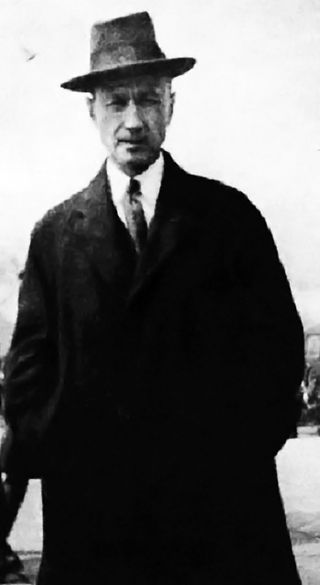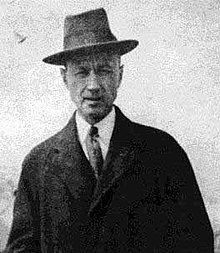
Charles Edward Ives was an American actuary, businessman, and modernist composer. Ives was amongst the earliest American internationally renowned composers to achieve recognition on a global scale. His music was largely ignored during his early career, and many of his works went unperformed for many years. Later in life, the quality of his music was publicly recognized through the efforts of contemporaries like Henry Cowell and Lou Harrison, and he came to be regarded as an "American original". He was also among the first composers to engage in a systematic program of experimental music, with musical techniques including polytonality, polyrhythm, tone clusters, aleatory elements, and quarter tones. His experimentation foreshadowed many musical innovations that were later more widely adopted during the 20th century. Hence, he is often regarded as the leading American composer of art music of the 20th century.
A tone cluster is a musical chord comprising at least three adjacent tones in a scale. Prototypical tone clusters are based on the chromatic scale and are separated by semitones. For instance, three adjacent piano keys struck simultaneously produce a tone cluster. Variants of the tone cluster include chords comprising adjacent tones separated diatonically, pentatonically, or microtonally. On the piano, such clusters often involve the simultaneous striking of neighboring white or black keys.

Symphony No. 40 in G minor, K. 550 was written by Wolfgang Amadeus Mozart in 1788. It is sometimes referred to as the "Great G minor symphony", to distinguish it from the "Little G minor symphony", No. 25. The two are the only extant minor key symphonies Mozart wrote.

The Piano Sonata No. 2, Concord, Mass., 1840–60 is a piano sonata by Charles Ives. It is one of the composer's best-known and most highly regarded pieces. A typical performance of the piece lasts around 45 minutes.
Jan Swafford is an American author and composer. He earned his Bachelor of Arts magna cum laude from Harvard College and his M.M.A. and D.M.A. from the Yale School of Music. His teachers included Earl Kim at Harvard, Jacob Druckman at Yale, and Betsy Jolas at Tanglewood. He has written respected musical biographies of Charles Ives, Johannes Brahms, Ludwig van Beethoven, and Wolfgang Amadeus Mozart as well as the Vintage Guide to Classical Music. He appeared in the award-winning 2018 German documentary The Unanswered Ives.

The Three Places in New England is a composition for orchestra in three movements by American composer Charles Ives. It was written mainly between 1911 and 1914, but with sketches dating as far back as 1903 and last revisions made in 1929. The work is celebrated for its use of musical quotation and paraphrasing.
String Quartet No. 1 is a musical composition by Charles Ives. Music historian and theorist Robert P. Morgan wrote that the quartet "was Ives's first mature composition of extended length, and its extraordinary fluency gives ample evidence of his solid control of traditional musical techniques. Moreover, the work is considerably more than a facile exercise based on classical models; there are already indications of the Ives to come, in the extensive quotations and, above all, in the composer's ability to bend the form to suit the idiosyncrasies of his own musical inclinations."
The Unanswered Question is a musical work by American composer Charles Ives. Originally paired with Central Park in the Dark as Two Contemplations in 1908, The Unanswered Question was revised by Ives in 1930–1935. As with many of Ives' works, it was largely unknown until much later in his life, and was not performed until 1946.
The Second Symphony was written by Charles Ives between 1897 and 1902. It consists of five movements and lasts approximately 40 minutes.

Charles Ives's Symphony No. 4, S. 4 was written between 1910 and the mid-1920s. The symphony is notable for its multilayered complexity—typically requiring two conductors in performance—and for its large and varied orchestration. Combining elements and techniques of Ives's previous compositional work, this has been called "one of his most definitive works"; Ives' biographer, Jan Swafford, has called it "Ives's climactic masterpiece".

The Symphony No. 73 in D major, Hoboken 1/73, is a symphony by Joseph Haydn composed in 1782. It is often known by the subtitle La chasse due to the hunting horn calls in the final movement, a popular trope in eighteenth century music.

The Symphony No. 68 in B-flat major, Hoboken I/68, is a symphony by Joseph Haydn. The symphony was composed in 1779 for Nikolaus I, Prince Esterházy. It is chronologically the last symphony by Haydn where the Minuet is second out of the four movements.

The Symphony No. 52 in C minor is one of the last Sturm und Drang symphonies composed by the Austrian composer Joseph Haydn while the composer was in residence at Esterházy in 1771 or 1772.

The Serenade for Orchestra No. 9 in D major K. 320, Posthorn, was written by Wolfgang Amadeus Mozart in Salzburg, in 1779. The manuscript is dated 3 August 1779 and was intended for the University of Salzburg's "Finalmusik" ceremony that year.
An offstage instrument or choir part in classical music is a sound effect used in orchestral and opera which is created by having one or more instrumentalists from a symphony orchestra or opera orchestra play a note, melody, or rhythm from behind the stage, or having a choir of singers sing a melody from behind the stage.
Symphony on a Hymn Tune is a four-movement orchestral composition by the American composer Virgil Thomson. The work was Thomson's first symphony and was composed between 1926 and 1928 while Thomson studied with the composer Nadia Boulanger in Paris. However, the work was not premiered until February 22, 1945, with Thomson leading the Philharmonic Symphony Society in New York City.

Variations on "America" is a composition for organ by the American composer Charles Ives.
Orchestral Set No. 2 is the title of a three-movement work by the American composer Charles Ives. A typical performance lasts around seventeen minutes. Composed between 1915 and 1919, it represents musical reminiscences of the composer. Like its predecessor, the First Orchestral Set, Three Places in New England, it was not conceived as a single entity but rather assembled from separate compositions.
The String Quartet No. 2 by Charles Ives is a work for string quartet written between 1907 and 1913. It was premiered at McMillin Theatre, Columbia University in New York City on 11 May 1946, by a Juilliard School student ensemble. Its first professional performance was by the Walden String Quartet, on 15 September 1946, at Yaddo, on a concert which prompted composer Lou Harrison to write: "This work is... the finest piece of American chamber music yet... Music of this kind happens only every fifty years or a century, so rich in faith and so full of the sense of completion." In his Memos, Ives referred to the quartet as "one of the best things I have".

Tone Roads No. 1 is a short composition for chamber ensemble by American composer Charles Ives. It was finished in 1911.







